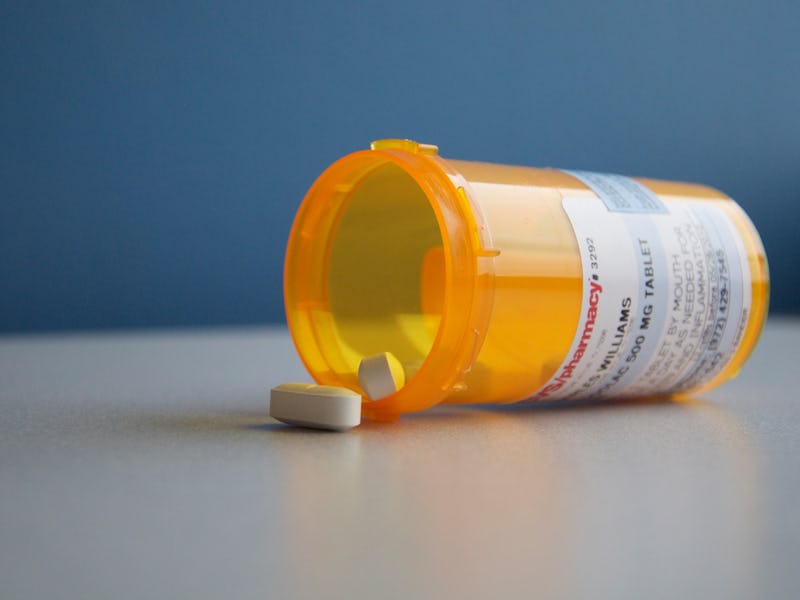What Makes FDA-Banned Opioid Opana ER Different From Other Drugs?
"It's similar to targeting Toyotas for road rage."

In June, the United States Food and Drug Administration requested that the drug maker Endo stop selling the powerful opioid Opana ER, citing concerns about abuse. This week, Endo obliged. It’s the first time the FDA has tried to get an opioid off the market because of its abuse potential and succeeded. What’s unclear, however, is what makes Opana ER different from all of the other opioids fueling the country’s addiction crisis.
Opana ER is a time-release formulation of oxymorphone, a semi-synthetic opioid that’s about 10 times as potent as morphine. Like many other prescription opioids, it is a powerful painkiller often prescribed for treating chronic pain, and it also has a strong potential for abuse and dependency. Since Opana is so strong, it has long been a desirable drug for people seeking recreational effects, relief from physical dependency, or both.
But you could say the same about a lot of opioids.
While Opana ER is indeed one of the more potent and desirable pharmaceutical opioids for people to use recreationally, oxymorphone doesn’t contribute to the current opioid epidemic any more than any other drug.
“It isn’t any one prescribed substance such as Opana that’s caused this ‘epidemic,’ but has more to do with how opiates are mis-prescribed. Emergency rooms aren’t going to stop using opioids nor are people going to stop seeking opioids,” said Van Asher, syringe access program manager at St. Ann’s Corner of Harm Reduction, a needle exchange in New York City, in an interview with Inverse. “It’s similar to targeting Toyotas for road rage.”
Van Asher works at a needle exchange clinic, where the worst ravages of the opioid abuse epidemic are felt.
In response to concerns about abuse, Endo reformulated Opana ER in 2012 to make it more abuse-resistant. In the new preparation, Opana ER pills still contained oxymorphone, but the ingredients were encased in a gel-based matrix. This made it harder to crush the pills to snort or inject them (imagine trying to snort bubblegum).
Anecdotal reports from drug users suggest that this didn’t stop anyone, though. Public determination to get high on Opana was especially clear on drug-based internet forums such as the popular BlueLight, which contains a thread titled, “The NEW reformulated round Opana ER Mega Thread v.1 really? again??”. On this thread, forum members — who aren’t just recreational users, but also dependent users and pain management patients — share their strategies for overcoming Opana ER’s time-release and abuse-prevention measures.
This same scenario played out with Oxycontin’s abuse-prevention reformulation in 2010: Drug users quickly put their heads together and found new and inventive ways to get past abuse-prevention measures, often using the PedEgg pedicure tool to shave down pills.
This is all to say that this latest move by the FDA, which is a significant milestone in the U.S. government’s efforts to address the opioid epidemic, is nonetheless not all that meaningful by itself.
Taking Opana ER off the market is probably a good thing, since people still inject the drug, despite the danger posed by fillers and binders in the pill that can clog a user’s veins. But it’s not, by any means. a comprehensive strategy for dealing with the opioid addiction crisis. There are still plenty of other opioids available on the market — both legal and illicit. It will take concerted efforts by federal, state, and local government to help educate drug users and doctors if we are to make progress against this public health crisis.
“The problem we’re facing today where in NYC we lost 1,347 people to accidental overdose last year and over 60,000 nationally (more than the entirety of losses in the Vietnam War) is due to the lack of quality control due to street drugs and counterfeit pills being sold,” Asher says. He suggests that Safer Consumption Spaces, where people can use drugs in a clean environment and receive education about how to reduce their chances of overdose or disease transmission, should be a significant part of public health strategy in the near future.
So even though this move by the FDA is unprecedented, without any other policy or regulatory changes, taking Opana ER off the market probably won’t do all that much.